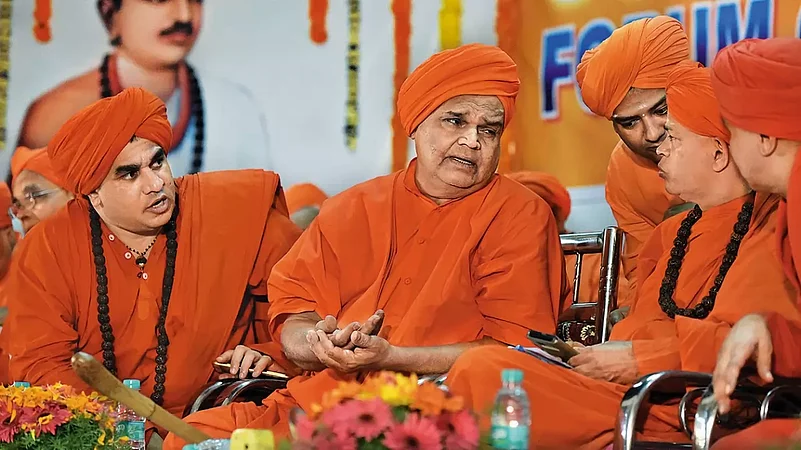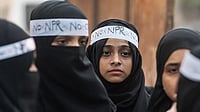In 2008, B. S. Yediyurappa had led the Bharatiya Janata Party (BJP) to victory in the Karnataka Assembly elections, a first for the party in a southern state. On August 4, 2011, Yediyurappa was forced to resign as chief minister of Karnataka after he was accused of corruption. He went on to form the Karnataka Janata Paksha (KJP), which secured nearly 10 per cent of votes in the 2013 Assembly elections and six seats. The incumbent BJP’s tally fell from 110 to 40 seats. The Congress, led by Siddaramaiah, won the elections with an absolute majority of 122 seats.
A decade later in 2021, facing corruption charges again, Yediyurappa was asked by the BJP to quit as chief minister. But he refused to be cornered and found support even from senior Congress leaders. Though he was replaced by Basavaraj Bommai, Yediyurappa continues to be an influential leader of the BJP and a member of its parliamentary board. The source of Yediyurappa’s influence is the support that he receives from the Lingayat community in the state. He has been backed by the All India Veerashaiva Mahasabha, a community organisation with a strong presence in 22 districts.
According to the 2011 Census, there were about 27 lakh Lingayats in India, a number that would have increased significantly over the past decade. Most of them live in Karnataka and the districts of Maharashtra and Telangana bordering the state. They also have a significant population in Andhra Pradesh, Kerala and Gujarat.
In Karnataka, members of the community have major landholdings. While they initially supported the Congress, land reform introduced by former chief minister, D. Devaraj Urs, alienated many of them, leading them to switch loyalty to the BJP. The community has also had a powerful presence in the political landscape of the state, producing at least three chief ministers besides Yediyurappa—Veerendra Patil, S.R. Bommai, and J.H. Patil. For many Lingayats in the state, Yediyurappa is the current bearer of this legacy.
An egalitarian sect
In the south Indian oral tradition, the Lingayat sect was founded in the 12th century by Basava, a theologian and religious reformer. Some sources claim that instead of founding the sect, Basava, who also served as administrator of the royal treasury of Kalchuri king Bijjala I, revived an older tradition. His life and teachings are recorded in the Basava Purana, a 14th-century Kannada poem by Bhima Kavi.

The Lingayats reject the caste system and are strongly anti-Brahminical. They also prefigured 19th-century social reform by campaigning against practices such as child marriage and the ill-treatment of widows. Basava’s followers got their name from the practice of wearing the linga, a votary symbol representing Shiva, around their necks on a thread instead of the sacred thread worn by Brahmins. The linga is usually placed in a small box made of wood or metal. Devotees in the community worship the linga, sometimes referred to as the Ishtalinga, every day in a ritualistic manner. Both men and women wear the linga and perform the ritual.
Birth, death and the life in between
Channavir Bhadreshwarmath, a researcher on the sect and the author of the Marathi book Sharan Gatha says, “Those who wear the Ishtalinga do not have to go to the temple as they consider their bodies to be temples. The commitment to the Ishtalinga is supreme and every Lingayat wears it from birth to the grave.”
The rituals surrounding the birth and death of the members of the community are also unique. A Lingayat priest performs the ritual and gives the pregnant woman an Ishtalinga. She wears it on her body until the birth of her child. At birth, the mother ties the Ishtalinga on the new-born child. Between the ages of eight and 11 years, a priest guides the child on the tradition of worship.
Most of them are strict vegetarians and do not consume alcohol or tobacco. The Lingayats reject the Vedas, Puranas, Shastras and other related mythologies, beliefs and traditions. “For us, Shiva is everything: the creator, the preserver and the destroyer. The Shiva in Lingayatism is very different from the Shiva worshipped by the Hindus,” says Bhadreshwarmath.
In Lingayatism, Shiva is not married and does not have any family or children. Therefore, Parvati, Ganesh, Veerabhadra, Skanda and Nandi, none of these exist for the Lingayats. Even their death rituals are as unique as their birth ones. When they die, the Lingayats are not cremated. They are buried in a meditative sitting position, holding the Ishta-linga in their right hand.
The great debate
A debate has been raging in Karnataka on if the Lingayats are the same as the Veerashaivas and whether they are Hindus or not. The feud between these two communities is based on the larger belief that both are the same. According to Lingayat scholars Outlook spoke to, the Lingayats are followers of Basava and reject practices like caste and gender discrimination, while the Veerashaivas accept the Vedic texts and practices like caste and gender discrimination with which they are associated.
The Veerashaiva faith is identical to the Brahmanical belief system that they are born from the ears of the Brahma, says a source. Basava had rejected the hegemony of the Brahmins. The Lingayats have been revolting against discrimination in the community by the Veerashaivas, who are politically and economically very influential.
Also, Basava propagated that women were equal in all aspects of life and accorded them equal status in the community. Women, too, wear the Ishtalinga on their person and are imparted the knowledge of worshipping it. Women perform most of the religious rites. There have been instances in the past when four Lingayat queens had ruled their respective states. These included Belavadi Mallamma, Kittur Chennamma, Kakatiya Rudramma and Keladi Chennamma.
Any person who is a follower of Lingayatism, either by birth or by conversion, can head the religious mutts of the community, as do many women in Karnataka. There are no taboos against menstruating women, child marriage is forbidden, widows can remarry and women can adopt children.
Fight for recognition
There have been numerous representations by various Lingayat organisations demanding recognition for Lingayatism as an independent religion. “Though we fulfil all the criteria that qualify us as an independent religion, the Centre refuses to give us the identity. We are being pushed to the background,” says a source from the community who did not want to be named.
In 2016, the Shiva Sanghatana, an organisation representing Lingayat youth in Maharashtra, launched a campaign demanding reservation for various Lingayat sub-castes under the Other Backward Classes and the Special Backward categories. The demand for a separate religious identity for Lingayats picked up pace in 2017, with demonstrations across the country. A year later, the Nagamohan Das Committee advised a separate religious status for the Lingayats. Though the Karnataka government granted them the status as a minority community, it did not recognise their belief system as an independent religion.
(This appeared in the print edition as "Egalitarian in Creed")


























